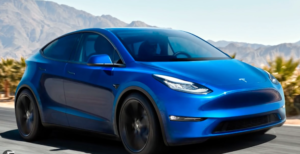Hawaii’s EV Transition Accelerating – Part One
Update Jan 10, 2024
U.S. BEV Sales Surge in 2023
Cox Automotive said on Tuesday that Americans bought 317,168 battery-electric vehicles in the fourth quarter, up 40% from 225,865 a year ago. BEVs accounted for roughly 8% of all new car sales in the fourth quarter and between 7% and 8% of total US vehicle sales in 2023.
Originally Published Jan 2, 2024
One in Two Cars Sold Worldwide Will Have an All-Electric Powertrain by 2030
US BEV (battery electric vehicle) sales for 2023 have surpassed 1 million in the United States, with global EV sales projected to reach were more than twice that number – it was also the first time Electric Vehicle sales exceeded that threshold in a single sales year.
The National Automobile Dealer Association (NADA) reported through first 11 months of 2023, BEV (100% electric) sales totaled 1,007,984 – an increase of 50.7% year-over-year.
Tesla alone is estimated to have delivered 1.82 million vehicles globally in 2023, up 37% from 2022, and of that total, about 473,000 vehicles in the fourth quarter. Tesla’s global EV sales numbers contradict media reports that the-sky-is-falling on EV consumer hopes and demand for electrification.
Over one million US sales in 2023 is a major milestone for the EV industry and a major step toward transportation electrification. National Automobile Dealer Association data supported the growth in EV demand with growth month-over-month increasing steadily from 6.4% of new vehicle sales in January to 7.2% in October 2023.
Still, overall, the US has lagged Europe and China in adopting EVs, and auto executives and politicians have been eager to catch up so America doesn’t lose the transportation technology race. But many auto buyers aren’t going along for the ride.
At present, EVs generally remain too costly for the average buyer with an average price of $60,544, about $13,000 more than the typical gas-fueled car, according to Edmunds Automotive.
Yet, for Hawaii, at least, the story is little different for consumers who do their homework before entirely dismissing a potential EV purchase. Tesla’s popular mass market SUV, the Model Y, starts at $36,490 after federal EV tax credit, a price that excludes taxes and fees. Hyundai’s appropriately named “Kona” EV for 2024 has a MSRP price of $32,675 (before taxes and fees). An another cost consideration, EV price premiums, recently, were even more painful as interest rate loans for autos has soared. The good news, as inflation recedes so are auto loan costs.
Also many potential EV buyers, before doing their homework investigating a purchase, generally see EVs as too risky if they run out of juice with no charger in sight. As explained later in this series, that is less an issue and worry for Hawaii’s island-based residents. Reading the tea leaves, every automotive company was full steam ahead on electrification a couple of years ago, but that momentum has slowed over the past six months.
General Motors announced it was backing down from its near-term goal of 400,000 units by mid-2024. Additionally, Ford Motor Company has halved its 2024 production guidance for its electric pickup truck, the F-150 Lightning.
Against this backdrop, Tesla’s 38% growth of such a large number is impressive. Growing large numbers isn’t easy. Increasing deliveries from 435,000 in Q3 to 484,000 in Q4 as your competitors slow? It’s a solid quarter. Tesla still sold 35 times the electric vehicles Rivian did in Q4, and unlike Rivian its sales grew sales quarter over quarter.
What does it all mean? One could argue that broader EV demand may have softened in recent months (more on this below). But rather than all EV companies suffering equally, consumers opted for the most established brand, Tesla.
Biden Policy Transforming America into a 21st Century Economy
It was 2023 which marked the best year for EV sales in our nation’s history, and with President Biden’s leadership, the enactment of the Bipartisan Infrastructure Law and the Inflation Reduction Act are the key Federal Policy enablers in the transformation of America into a competitive 21st century clean tech economy. US investments in the development and manufacturing of EV’s, batteries also are producing new and well-paying jobs within technology foundation essential to America’s global competitiveness.
Biden administration’s Inflation Reduction Act has also attracted $103 billion in new private sector investment announcements, including the manufacturing of EVs ($11 billion), batteries ($72 billion), as well as other areas accompanying industrial investments in battery components ($10 billion) and recycling ($4 billion). The first IRA-related and globally competitive EV and battery factories are scheduled to open in the second half of 2024, with more coming online in 2025 and beyond.
Transitioning to EV manufacturing and products is apparently harder than it appears for conventional ICE automakers
Bloomberg reported that traditional automakers rush into the electric vehicle sector was to scale their business into EV’s, but in attempting to do it, Ford and General Motors have since opted to scale back their EV goals. Cathie Wood of ARK Investments, who current holds a large position in Tesla, stated … “We expected a lot of traditional auto manufacturers to see the writing on the wall and rush as quickly as they could into scaling big time into electric vehicles. And what has happened recently? Both GM and Ford have said, ‘We’re stepping back. We’re not going to do this until it’s profitable,’” Wood noted.
Wood’s comments about Ford and GM are quite accurate. General Motors was planning to produce 400,000 electric cars by mid-2024, but this target has been abandoned, as per CFO Paul Jacobson. The production of the electric Chevrolet Silverado and GMC Sierra will be delayed by a year as well, as noted in a Fortune report. Ford, meanwhile, has slashed its F-150 Lightning output from 3,200 to 1,600 per week over production and demand concerns.
“The problem with that is in order to be profitable, they (Ford and GM) need to scale. That’s how this works. Their learning curve as traditional ICE (Internal Combustion Engine )vehicle makers may be longer than anticipated as they write down costs. So the fact that they’re pulling back means there’s more market share for Tesla in its growing EV leadership role, and for others who choose to go for it,” Wood said.
Interestingly enough, the EV sector is still growing pretty well in the United States. J.D. Power has noted that about 869,000 electric cars were sold in the US in the first ten months of the year. That’s a jump of about 56% year-over-year. This jump, however, was likely driven mostly by Tesla, whose mainstream vehicles like the Model Y crossover and Model 3 sedan dominate their respective market segments.
Tesla’s lowest cost and mass-market all-electric 4-5 passenger utility vehicle is said to be in the early stages of development and projected to be priced in the $25,000 range.
 The new vehicle is code name the Model 2 by the media. It is expected to incorporate the economic, manufacturing, technology lessons and growth of Tesla’s recent past and which will guide the vehicle’s development and accelerate its time-to-market. The Model 2’s low entry price is targeted at $25,000, with little compromise anticipated in vehicle utility, performance, and range compared with Tesla’s current line of luxury models.
The new vehicle is code name the Model 2 by the media. It is expected to incorporate the economic, manufacturing, technology lessons and growth of Tesla’s recent past and which will guide the vehicle’s development and accelerate its time-to-market. The Model 2’s low entry price is targeted at $25,000, with little compromise anticipated in vehicle utility, performance, and range compared with Tesla’s current line of luxury models.
The days of the sub-$10,000 new car are long behind us, and the days of the sub-$20,000 new car may not be far behind. But if a rock-bottom price is what buyers are looking for there is limited choice, variety, in ICE (gas-powered) models and makes.
Today’s lowest cost 2023-24 gas-powered vehicle examples:
- Mitsubishi Mirage ES: $17,790
Kia Rio LX: $17,875
Nissan Versa S: $18,745
Kia Forte LX: $20,815
Hyundai Venue SE: $20,985
Kia Soul LX: $21,215
Chevrolet Trax LS: $21,495
Nissan Sentra S: $21,725
Hyundai Elantra SE: $22,065
But it’s the affordable $25,000 mass market vehicle price range in which Tesla is aiming at with the introduction of the all-new, all-electric, and low cost Model 2. A price point today exemplified by the 2023-24 gas-fueled Chevrolet Trailblazer and Toyota Corolla Crossover.
See part 2 of this BeyondKona exclusive story and discover…
“Why going all-electric in Hawaii makes sense for many of the state’s residents today”




Leave a Reply
Join the Community discussion now - your email address will not be published, remains secure and confidential. Mahalo.